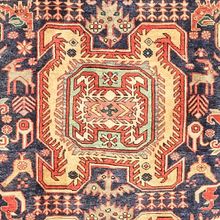Difference between revisions of "Ardebil Rug"
Jump to navigation
Jump to search
| Line 15: | Line 15: | ||
|Origin = {{flag|Iran}}: Ardabil | |Origin = {{flag|Iran}}: Ardabil | ||
| − | |Category = | + | |Category = Village, City |
|Prime examples = | |Prime examples = | ||
|Master designers = | |Master designers = | ||
| Line 22: | Line 22: | ||
<!--Technical information--> | <!--Technical information--> | ||
| − | |Common designs = [[Medallion]] | + | |Common designs = [[Medallion]], [[Herati]] |
| − | |Common motifs & patterns = | + | |Common motifs & patterns = |
|Common sizes = | |Common sizes = | ||
|Common colors = Turquoise, White, Ceram, Navy Blue, Green | |Common colors = Turquoise, White, Ceram, Navy Blue, Green | ||
| − | |Dyeing method = | + | |Dyeing method = Natural, Synthetic |
|Pile material = | |Pile material = | ||
|Foundation material = [[Wool]], [[Silk]] | |Foundation material = [[Wool]], [[Silk]] | ||
| Line 39: | Line 39: | ||
==History== | ==History== | ||
| − | |||
| − | |||
| − | |||
| − | |||
| − | |||
| − | |||
| − | |||
| − | |||
| − | |||
| − | |||
| − | |||
| − | |||
| − | |||
| − | |||
| − | |||
| − | |||
| − | |||
| − | |||
| − | |||
| − | |||
| − | |||
| − | |||
| − | |||
| − | |||
==See also== | ==See also== | ||
| − | |||
| − | |||
| − | |||
| − | |||
| − | |||
| − | |||
| − | |||
</gallery> | </gallery> | ||
{{Wikipedia}}<br> | {{Wikipedia}}<br> | ||
<br> | <br> | ||
| − | |||
==References== | ==References== | ||
{{Reflist}} | {{Reflist}} | ||
| − | |||
==Bibliography== | ==Bibliography== | ||
| − | + | # Abraham Levi Moheban. 2015. ''The Encyclopedia of Antique Carpets: Twenty-Five Centuries of Weaving''. NewYork: Princeton Architectural Press. | |
| − | |||
[[Category:Persian Carpets]] | [[Category:Persian Carpets]] | ||
[[fa:قالی_اردبیل]] | [[fa:قالی_اردبیل]] | ||
Revision as of 14:04, 4 August 2020
| Ardebil Rug | |
|---|---|
 Design of Ardabil Rug (Rugman) | |
| General information | |
| Name | Ardabil Rug |
| Original name | قالی اردبیل |
| Alternative name(s) | Ardabil Carpet |
| Origin | |
| Category | Village, City |
| Technical information | |
| Common designs | Medallion, Herati |
| Common colors | Turquoise, White, Ceram, Navy Blue, Green |
| Dyeing method | Natural, Synthetic |
| Foundation material | Wool, Silk |
| Weaving Technique | Cotton |
| Knot type | Symmetrical (Turkish), Asymmetrical (Persian) |
Ardabil rugs originate from Ardabil, located in the East Azerbaijan Province but is today the Ardebil Province of northwestern Iran. Ardabil has a long and illustrious history of Persian carpet weaving. The reign of the Safavid Dynasty in the 16th and 17th centuries represented the peak of Persian carpet making in the region. The name Ardabil comes from the Avesta (The sacred book of Zoroastrians) with the word Artavil literally meaning a tall holy place. The weavers in Ardabil ply their craft using Persian knots. One of the most famous carpets in existence today is a Persian carpet from Ardabil. This magnificent masterpiece measuring 34' x 17' is hanging on display in the Victoria and Albert Museum in London, England.
History
See also
</gallery>
| Search for Ardebil Rug on Wikipedia. |
References
Bibliography
- Abraham Levi Moheban. 2015. The Encyclopedia of Antique Carpets: Twenty-Five Centuries of Weaving. NewYork: Princeton Architectural Press.